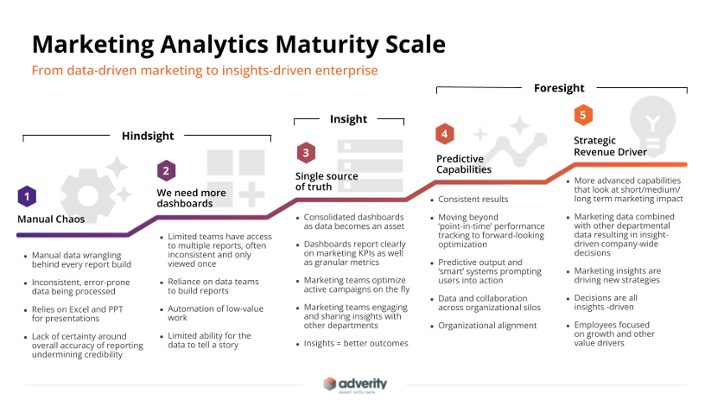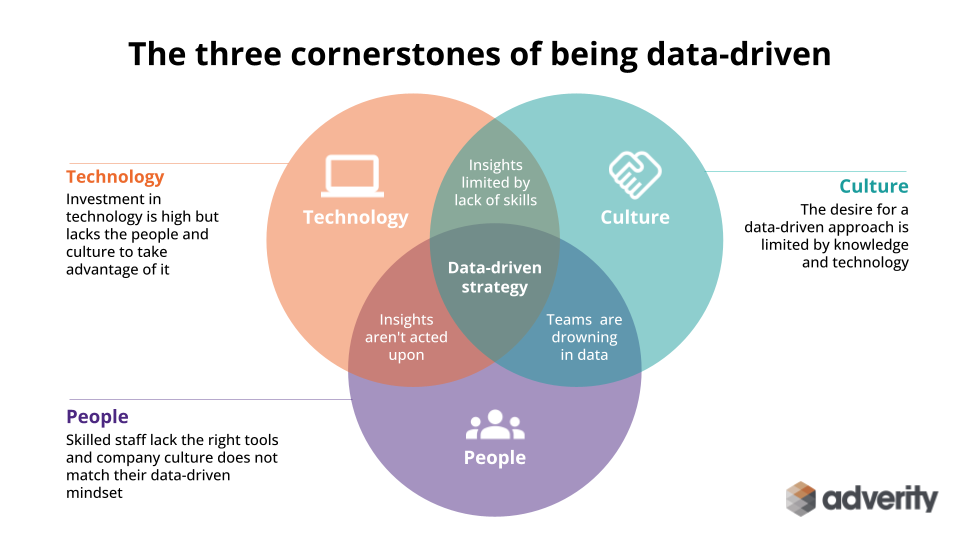Whenever we meet a new client one of the first things we do is try and decide where on the marketing analytical maturity scale they sit. Where are they on their journey to becoming more data-driven?
More often than not, most marketing teams want to be at stage five (see below) - the strategic revenue driver utilizing predictive analytics and AI and other cool and shiny things. And why not - who wouldn’t?
However, just as often, we find that businesses are, in reality, still somewhere between stage one or two of their data journey. And, in order to get to where they want to be, it is often surprising to them that there is a lot of work, preparation, and basic standards of data management that need to be addressed first.
Thus, we’ve put together a quick guide to the sort of questions that every business needs to ask right at the beginning of their data journey and the kind of steps they can take now to prepare the way forward.

Where is your organization on the Marketing Analytics Maturity Scale?
What is the first step marketers should take to manage their marketing data?
The first thing to do is to take a step back and understand the journey you’re about to embark on. Developing a robust, sophisticated, and modern marketing data management system does not happen overnight.
It is a multi-disciplinary project that takes time and resources before it produces results. So, it is integral to recognize the length and complexity of that journey.
Here are three key pieces of advice when
it comes to taking your first steps;
1. Don’t run before you walk
Before you even begin to start thinking about the shiny exciting things on the far right of that analytical maturity scale, you need to get your house in order. Trying to do advanced analytics with inaccurate, inconsistent, messy data is a waste of time. So, don’t get ahead of yourself, and take things step-by-step if you want to succeed.
2. Think ahead
Don’t choose a technology/governance framework thinking only of the here and now. Instead, build a vision of how you want things to look two or three years down the line and plan accordingly. Short-term challenges are exactly that, but if you set up your marketing analytics approach with only those challenges in mind, you limit your ability to grow beyond that.
3. Think holistically
Technology is only a piece of the puzzle - so don’t think that buying some shiny new tech will save your company overnight. It won’t. Certainly having the right tools and technology is crucial to successful data-driven digital marketing. But, equally important will be things like processes, ownership, people, key stakeholders, and change management - all these factors will play a role in a successful transition to data-first marketing.
Who should be responsible for managing data in the organization?
So, once you have taken that step back and planned accordingly, you need to start thinking about what is the best way to organize your data team - Who is going to be responsible? Where in the business will this team fit? Who will it report to?
Now, there is no one-size-fits-all when it comes to building the best organizational structure for managing your data. Things like current internal structure, go-to-market model, level of data and analytical maturity, the technical landscape (both people and technology), and the overall company culture will influence what the right model is for your company.

Technology alone is not enough to ensure a data-driven business - you need the right culture and people too.
So, once you have taken that step back and planned accordingly, you need to start thinking about what is the best way to organize your data - i.e. what architecture and rules will you put in place? Where will your data live? Who is going to be responsible?
Now, there is no one-size-fits-all when it comes to how to build the best system for organizing your data. Things like internal structure, go-to-market model, level of data and analytical maturity, the technical landscape (both people and technology), and the overall company culture will influence what the right model is for your company.
However, there are three key questions that apply to any business:
1. Centralized or not?
You can have data as a shared centralized service or distributed across different business units. Both have their pros and cons however if you go distributed, you need a centralized governance and architecture function to support the distributed teams. Research shows that centralized governance and architecture drastically help with accelerating and extracting the maximum value from your data while reducing the risk of internal competition between various parts of the organization.
2. In-house or outsourced?
In most cases, the natural fit is a mix of the two. But which side the mix is weighted tends to depend on individual company culture. Data talent is expensive and difficult to find but becomes the brains of the business. On the other hand, in the long term, outsourcing everything can be more expensive and give you less control.
3. Who will own this?
IT unit, a Business-unit, a stand-alone function? Usually, the most effective place for a marketing data management team to live is directly in Digital or Strategy teams alongside or working closely with a marketing operations manager - if such a function exists in your business. But, regardless of where it lives, for data to be effective, the team responsible needs a certain level of internal authority as well as access and visibility to the C-suite.
Who are the key stakeholders you should involve?
The next key thing to consider is which stakeholders are likely to be involved - both in terms of establishing and implementing a new marketing data management system, but also in terms of the key users. Speaking to all these stakeholders and understanding their needs is crucial for ensuring an effective marketing data model.
Also, it is important to establish internal champions as soon as possible. Most usefully, this will be the C-Suite but also consider which other teams and leaders will benefit from the new system. Get them on board early to help drive the project forward!
It’s important to note that this is not restricted to internal teams either. Instead, your new data management and governance will impact and be impacted by a range of external partners and stakeholders too. For instance, consider how your new marketing data management might be influenced by different vendors. Do you use an agency? What input do they need?
The following list is far from exhaustive but is a good place to start for most teams.
Internal:
- C-Suite (for sponsorship and support)
- Business Unit leaders (for direction and purpose)
- Operational key users (for “ears on the ground”)
- Information Security
- IT
External:
- Agencies
- Key partners (especially on your go-to-market model)
- Technology providers
- Strategic consultancies
Next Steps
Once you’ve undertaken these preliminary steps, you can really get to work planning out how your new data management system is going to look and start exploring the different tools you are going to need for your marketing data stack.
Naturally, we suggest checking out the first two modules in our platform that will help you connect and automatically integrate all your data sources and then visualize all that data in beautiful dashboards. This should take your business all the way to stage three where you can really start extracting the most amount of value and insights from your data, preparing the way for reaching the shiny status of stage five’s strategic revenue driver.
Related Articles
- 7 Building Blocks of Good Data Governance
- What is a data lake vs a data warehouse (and why should marketers care)?
- What is a single source of truth (and why should marketers care)?














